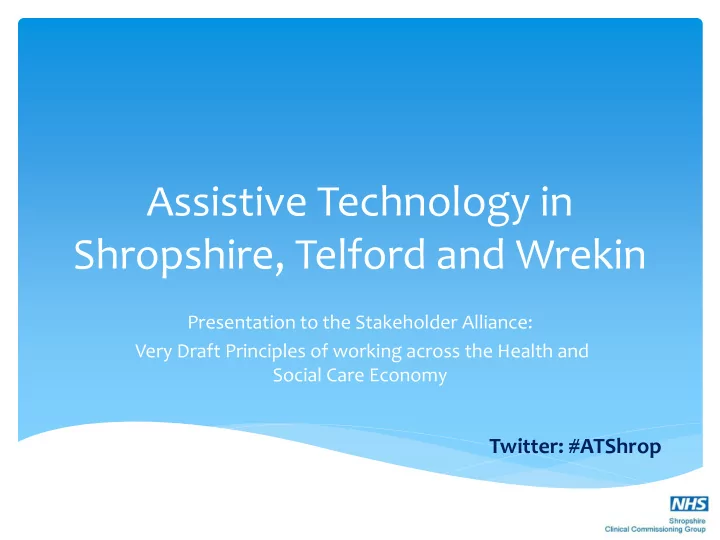

Assistive Technology in Shropshire, Telford and Wrekin Presentation to the Stakeholder Alliance: Very Draft Principles of working across the Health and Social Care Economy Twitter: #ATShrop
“Disclaimer” This presentation is a very early version of work completed over the summer of 2013 This group is seeing this before it has been formally fed back to organisations The group is asked to treat this presentation as work in progress and as work that it can influence at a very early stage, but that will change over the next month as feedback is received.
Purpose of Presentation To gain feedback from the stake holder alliance on very early draft ideas To discuss the process for further development
Process Met with senior managers/directors from all organisations represented on assistive technology group during July, August & September Standard list of areas to discuss Out of meetings generated a set of six areas for consideration by group, HWBB, individual organisations. Also identified some immediate actions NOT an assistive technology strategy Will also produce a document of evidence/case studies and list of definitions
PRINCIPLE ONE - Assistive technology is recognized as an enabler to solving identified problems Don’t just buy equipment – needs to be an identified problem to solve and clear strategic advantage within and across organisations Marry appropriate technology to appropriate patient Action All organisations should introduce the following question when assessing strategies and business cases:- “Does this strategy consider how assistive technology could enable the improvement of the patient experience and cost effectiveness”
PRINCIPLE TWO - Assistive technology will be embedded into systems and processes. Where distance and physical space restrictions exist, assistive technology should be seriously considered to support. Is this 2 principles???? Don’t treat as an add on – integrate into pathways Sites at distance – whether within the same organisations or across organisations – simple remote systems should be used if practical Action Each large transformational change project should include a sub- group to assess the role that assistive technology could have on supporting the transformation.
PRINCIPLE THREE – Individual Boards will take the lead on implementation of assistive technology, while ensuring communication across the health and social care economy to ensure systems will work together in the future Interoperability of systems Recognise differences in geographic areas and organisational strategic directions Understand and respect the differences between organisations, but work in a common direction important that the health and social care economy are aware of initiatives to allow potential linkages
Actions Continued Action 1. Each board should nominate a director lead for assistive technology 2. All organisations decisions to commission assistive technology should ensure systems have interoperability built into them 3. Each organisation should supply, on a six monthly basis, data relating to the assistive technology projects they are delivering and planning, to be placed on a public facing website
PRINCIPLE FOUR – All organisations will increase the level of understanding of their staff regarding assistive technology a basic level of awareness of “what is possible” principles underlying the introduction of assistive technology in the future Action Articles should be placed in all organisations newsletters regarding assistive technology
PRINCIPLE FIVE – Organisations will work together to increase members of the public understanding of assistive technology 97% of those polled by YouGov did not know what telecare or telehealth was messages should be simple and consistent across the health and social care economy If replacing human contact need understanding from public and systems to compensate as necessary interactive sites that advertise what is available in assistive technology and ?“show” houses?
Continued Action The CCG, with the support of patients groups and the public, should run a series of awareness raising workshops. A full proposal of projects to improve public understanding should be created.
PRINCIPLE SIX – Technology should only be implemented after it can be demonstrated that it is cost saving or cost neutral. Evidence base for assistive technology and particularly large scale implementation of telehealth and telecare is unclear (3 million lives) Telehealth – small scale projects in specific disease areas and how implemented matters Whole Systems Demonstrator – evidence for telehealth still developing The evidence for telecare is stronger, but recent large scale implementations (such as in Birmingham Council) have not delivered the level of change anticipated.
Continued We need a system ….to commission by pathways ….and to share benefits across organisations ….and to avoid optimism bias Roll for HWBB or assistive technology group to assess cross organisational proposals? Create resource of evidence and case studies of projects that have worked Large scale implementation of telehealth is not undertaken in Shropshire and Telford and Wrekin for next ?2 years? Until more evidence Avoid stagnation by having projects focused on areas of change
Continued Action A further assessment of evidence should be completed and presented to the Health and Well Being Board and all partners across the Health and Social Care Economy in the Summer of 2014 Consideration of small scale projects, based on case studies from elsewh ere and known requirements in Shropshire, Telford and Wrekin should be produced.
Views What is good? What have we missed? What have we put in that should be left out? Is it coherent? Process for involvement?
Recommend
More recommend